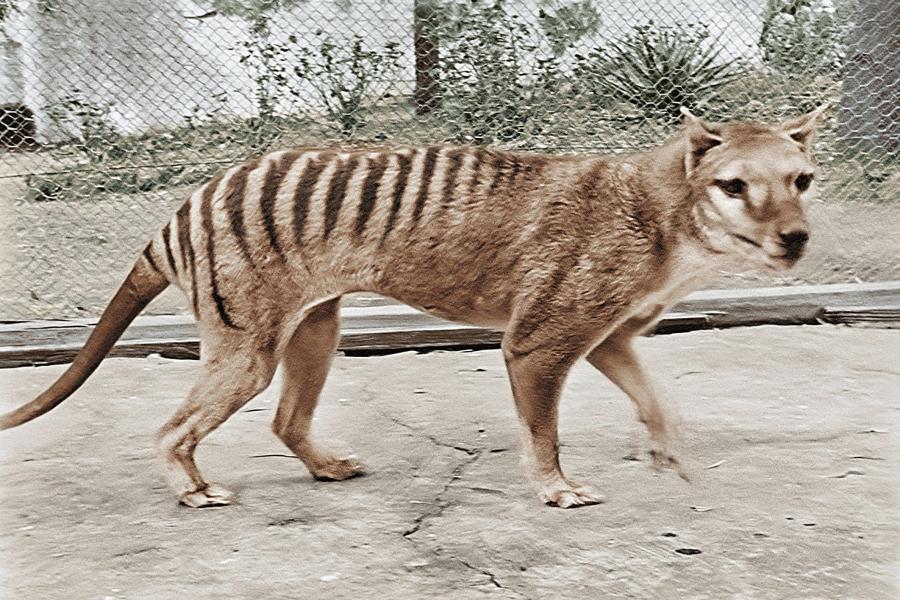What emotions do these images of animals evoke in you?


Thylacine
'Tasmanian Tiger in Colour'
2021
Original film David Fleay. Colourised by Samuel François-Steininger of Composite Films
The last captive Thylacine paces in its cage at Hobart Zoo, 1933, colourised 2021
More about this image-
Bright emotions
-
Not at all Extremely
-
-
Quiet emotions
-
Not at all Extremely
-
-
Heavy emotions
-
Not at all Extremely
-
-
Sombre emotions
-
Not at all Extremely
-
Species: Thylacine (Thylacinus cynocephalus)
Location and habitat: Tasmania, Australia
Conservation Status: Extinct

Compare yourself to others
Choose different variables below, and see the patterns of response reflected in the circle of emotion above. Your responses are the coloured wedges. Others' responses are averaged in the spider graph of lines and dots.

Title: 'Tasmanian Tiger in Colour'
Creator: Original film David Fleay. Colourised by Samuel François-Steininger of Composite Films
Date: 2021
Medium: 16mm film, digitally colourised
Publisher: National Film and Sound Archives, Australia
Copyright: Used with permission.
The thylacine is a flagship of contemporary extinction. Indeed, we've used a photo of one -- a female held in a concrete floored cage in a zoo in London -- front and centre for our Extinction Imaginaries project, to which this research belongs. This largest of the marsupial predator, also known as the 'Tasmanian tiger', were hunted to extinction because of their perceived threat to livestock, with a state-backed bounty placed upon their heads. The last known thylacine -- pictured above -- died in Hobart Zoo on the 7th of September, 1936. This endling, a female, posthumourly called 'Benjamin', was skinned, displayed in a museum where the preserved corpse pelt was patted by generations school children, until it spent decades lost in the back of a cupboard somewhere random in the museum. A few minutes of her imprisonment was captured on black-and-white 35mm film by Australian zoologist David Fleay in 1933. 85 years to the day later, Australia's National Film and Sound Archives released footage which had been digitally colourised in 4K quality footage, and the result is haunting: a strange, dog-like marsupial, is rendered uncannily present as it waits for its doom in a scrappy prison. They thylacine is an example of another unique species that has been annihilated by human activity: another notch carved into the grim belt of the 6th Great Extinction.
Jump forward most of a century to our strange historic moment, and the thylacine has become a key focus of a rather questionable project: 'curing' extinction via genetic engineering. One company currently working to try and 'resurrect' the thylacine is the American company Colossal Laboratories & Bioscience, whose put the matter thus: "Extinction is a colossal problem facing the world. And Colossal is the company that's going to fix it". The sheer hubris in this official catchphrase is impressive, even by Silicon Valley's lofty standards. Colossal is the latest start-up by tech billionaire Ben Lamm, and it's self-proclaimed mission is to use biotech for 'de-extinction', resurrecting resurrect long lost animals under the dubious assumption that they would protect our ecosystems, thus saving-the-world. Colossal use genetic technology such as "clustered regularly interspaced short palindromic repeats" (CRISPR) to hack into the DNA of existing animals and make some minor tweaks that can help their engineered offspring to resemble extinct related species. The fact that the creatures produced are GM hacked hybrids more so than a 'resurrected' lost species, does not bother a hype hungry media. TIME Magazine write a cover story exalting Colossal's efforts, helping them to raise publicity and, potentially, speculative venture capitalist investment.
The question of using bio-tech to 'de-extinct' a species is proving very difficult to consider at a time when our social capacity to seriously think through structural problems is at a real low. Any meaningful public debate on the subject needs to think through the developments that make such an engineering project possible, and their social consequences. This involves considering the social psychological questions of why this deep unsettling of the world is often swallowed as a self-evident good. Richard King puts the matter well:
This is not a scientific question, or even just an ‘environmental’ one. It is a question about our place in nature, about the kinds of creatures humans are, and about the moral and ethical ‘ecosystem’ in which future generations will find themselves. My feeling is that if we continue to regard the physical world, and all physical beings, as so much stuff to be manipulated, we could land ourselves in a situation at least as bleak as Benjamin’s: alone in a featureless pen of our own making, increasingly uncanny to ourselves and to one another.





